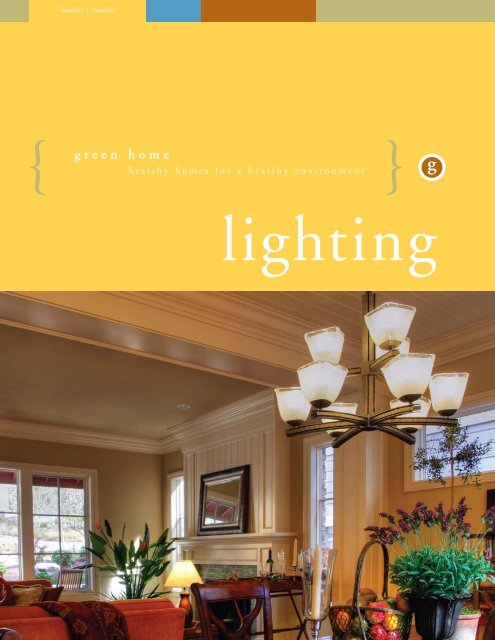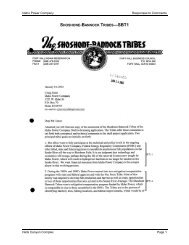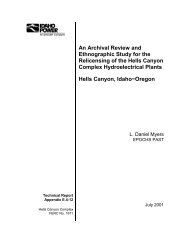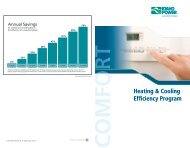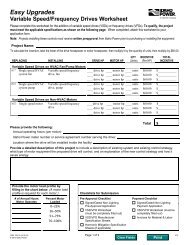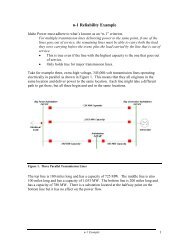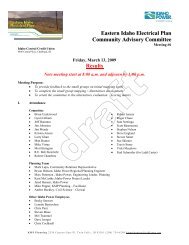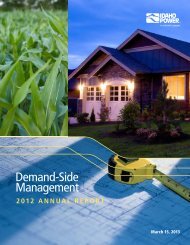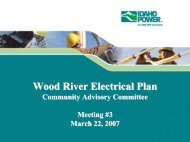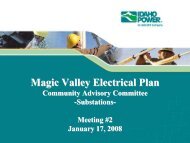Green Home Lighting Guide - Idaho Power
Green Home Lighting Guide - Idaho Power
Green Home Lighting Guide - Idaho Power
- No tags were found...
You also want an ePaper? Increase the reach of your titles
YUMPU automatically turns print PDFs into web optimized ePapers that Google loves.
greenlightinghowWhat is a green home?It’s an approach to design, constructionand home improvements with the goalof not only making your home lookbetter, but work better for both youand the environment. A green homecan be healthier. It can also providelower utility bills, reduced maintenancecosts and a cleaner planet!Our <strong>Green</strong> <strong>Home</strong> Remodel <strong>Guide</strong> seriescovers common remodeling topics andgives helpful hints on materials andstrategies to create a home that'shealthy, saves money, and is easy onthe environment.The other guides in the series include:■ Remodel Overview■ Bath & Laundry■ Kitchen■ Painting■ Landscape Materials■ Roofing■ Hiring a Pro■ Salvage & Reuse■ Do-It-Yourself <strong>Home</strong> EnergyAudit <strong>Guide</strong>■ <strong>Green</strong> <strong>Home</strong> Buyer's <strong>Guide</strong>Available atwww.seattle.gov/dpd/greenbuildinggreen home | lightingWhat is efficient lighting?<strong>Lighting</strong> is a crucial component of acomfortable, safe, attractive and efficienthome. Yet all too often, even in “green”homes, little consideration is given tolighting design. Misconceptions regardingthe inferiority of efficient lighting arestill common.We’ve entered a new era. As you’ll learnin this guide, efficient lighting comes in adiversity of styles and functionalities whichhelps to create flexibility for the discerningdesigner and homeowner.According to the ENERGY STAR ®program, if all of America’s homesreplaced their five most used lights withENERGY STAR qualified lamps, we couldcollectively save eight billion dollars a yearin energy costs and prevent greenhousegas emissions equivalent to removing tenmillion cars from the road each year.At the individual home level, lightingaccounts for between 5 – 10% of ahome’s energy use. <strong>Lighting</strong> chosen forits durability, efficiency and appeal willlast 6 – 20 times longer (depending onthe lamp type) and cost less to operateand maintain.How can I use this guide?Whether you are just changing lamps,replacing existing fixtures, or consideringan integrated lighting design, this guidewill give you the tools to select the bestproducts and technologies for yourneeds. It will also:■ Introduce you to the technologyand art of efficient lighting design.■ Give you the knowledge to talkintelligently with design andlighting professionals.■ Serve as a launching point for youto create a beautiful and efficientlighting plan that benefits you,your family and the environment.Cover photo: Tom WoltjerTop photo: Lithonia <strong>Lighting</strong>
1contents601IntroductionA new way to think about lighting.05TechnologyThe technology and terminology behind lighting.09Choosing the Right LightDevelop a home lighting plan that suits your needs.11Lamping OptionsA guide to help you select appropriate lamps for your fixtures.1612<strong>Lighting</strong> Control OptionsSelecting the right lighting controls for each location.13<strong>Lighting</strong> Choices Room by RoomSelecting the right light for each location.16Health & SafetyInformation on installing, removing or operating lighting products.17GlossaryDefinitions of common lighting terms.2020ResourcesWhere to get more information on efficient lighting.green home remodel | landscape materials
introductionGone are the days when a round ceiling fixture with two 60-watt incandescent lightbulbs was the preferred lighting option for most of the rooms in a home. Now there arean overwhelming number of light bulbs and fixtures from which to choose. As you willlearn in this guide, you can choose bulbs that vary in color temperature, beam spread,light intensity, power consumption and longevity to name a few. And besides all theaesthetic choices, there are a myriad of fixture types that include wall sconces, pendants,chandeliers, ceiling fixtures, recessed cans and vanity strips. To help you get started insorting out all these choices, you will find on the next page a list of important featuresto consider when replacing or adding new lighting.Let this guide serve as astarting point for your research.Remember, every decision youmake regarding your lightingproject can help improve yourhome’s performance – foryou, your family and theenvironment.gFIRST, A WORD ABOUT TERMINOLOGY:Most homeowners use the term “light bulb” or “bulb” whenreferring to a light source; and the term “lamp” when referringto a light fixture. However, the lighting industry uses theterm “lamp” when referring to the light source and the term“luminaire” when referring to the actual housing of the lightsource. Throughout this guide we will use the term “lamp”when referring to a light source but use the more colloquialterm of “fixture” when referring to the housing.1 green home | lightingPhoto top left: Lithonia <strong>Lighting</strong>Photo top right: Nuvo <strong>Lighting</strong> a Satco ProductPhoto left: <strong>Lighting</strong> for Tomorrow and American Fluorescent (2008 winner)Photos right middle and bottom: Seagull <strong>Lighting</strong>
Decide What You WantWhen considering any type of new lighting, the first step is to identify and prioritizethe goals of your project.FunctionalityYour lighting should put light where it’s needed, in sufficientamounts, while consuming the least amount of power (watts).It should allow for comfortable performance of daily tasks. Thinkabout where the activities usually occur in each room. Theseareas will need adequate task lighting. In other areas, ambientlighting may be enough. (See page 9 for more information.)Your lighting controls should provide maximum flexibility for avariety of light levels and ease of use.Efficiency/CostLook for the ENERGY STAR label when choosing new lamps andfixtures. Make sure your choices include automated energysavingfeatures where appropriate, such as occupancy sensorsor timers. Select lamps that have a long life for maximum savingsand minimal replacements.Beauty/AestheticsCheck that your lighting choices allow for a diversity of effectsand applications, such as color temperatures, beam spreads,and direction light is focused. Consider highlighting interestingarchitectural elements, special artwork or décor.Ecological BenefitsSelect energy efficient lamps for minimal toxic content. Plan forproper disposal when lamps burn out. Outside lighting shouldminimize “light trespass” into neighboring properties and thenight sky.Safety & SecurityYour outdoor lighting should allow for safe movement byidentifying uneven surfaces and other hazards. It should providesoft, non-glaring light to help you discern between wanted andunwanted visitors, and help identify your home for guests andemergency personnel. Indoors, the design should help identifytransition areas such as counter edges and floor height changes.Avoid unshielded light sources that can cause glare.green home | lighting 2
Expand Your Definition of CostConsumer decisions are often driven by the initial price tag on an item, with little regardfor the long term costs. With the uncertainty of future energy costs, consumers havebegun to consider the ongoing energy costs of their purchases. The initial price of anincandescent lamp, for example, is usually less than the price of a compact fluorescentlamp (CFL). But when you consider that a CFL lasts 6 – 10 times longer and takeenergy prices into account, the true dollar cost becomes clear.Do Your <strong>Home</strong>workThorough research helps you ask the right questions of retailers, designers andcontractors and avoid costly mistakes. It pays to start your research early, looking formanufacturers and retailers that offer the products that meet your needs and desires.You may wish to keep an electronic or paper file of contact names and businesses, andmagazine and newspaper clippings that show products and design strategies you like.Consider hiring a design professional. With the recent increase of high qualityefficient lighting options, many forward-thinking designers are now specializing inhigh quality designs that incorporate energy-efficient lighting choices. Good lightingprofessionals can help you accomplish the priorities you identified in the Decide WhatYou Want section.Identifying all the items for your new lighting scheme – down to the fixture and lamptypes – will help you determine cost and availability and reduce the need for expensive,last minute decisions. Factor into your schedule how long it takes to receive specialorderitems. When visiting lighting showrooms, ask to see samples of ENERGY STAR-3 green home | lightingPhoto left middle: Seagull <strong>Lighting</strong>Photo left bottom: Tacoma <strong>Power</strong>
qualified lamps and fixtures, and advice on how to best use them. (Keep in mind thatsome showroom sales staff may still have outdated ideas about efficient lighting andwill direct you away from efficient choices.) The Internet is also a great place to searchfor information and products, but be aware of biases in information sources. The linebetween a sales pitch and factual information can be quite blurry. See Resources at theend of this guide for recommended places to begin.Universal DesignUniversal Design is a concept that reinvents the basic assumptions we have made indesigning the spaces where we live and work and the products we use. The result ismore flexible, adaptable spaces and products useful to a wide range of ages, sizes, orphysical abilities. These principles can help homeowners age in place and reduce theneed for costly and wasteful tear-out and remodeling activity down the road.<strong>Lighting</strong> strategies that put light where needed and allow for the increased lightingneeds of elders help create welcoming and safer spaces for all. Rocker switches (alsoknown as “Decora style”) allow for easier on-off function than do small toggle switches.Switches located between 36 and 42 inches above the floor, measured to the centerof the switch, allow access from various heights. Switches located both at the top andbottom of a set of stairs allows for safe passage in both directions. Visit the AARPwebsite at www.aarp.org/families/home_design for more tips on Universal Designstrategies you can incorporate into your home.green home | lighting 4
technologyUnderstanding the technology and terminology behind lighting will help you navigate thepotentially confusing territory of design and product selection.Light SourcesThere are numerous light sources available; the two most popular for residential applicationsare incandescent and fluorescent.IncandescentIncandescent light sources generate light from heat. Any object heated to a suitably hightemperature will emit light. We’ve all seen how hot stove burners glow red. The filamentof an incandescent lamp must be heated to an even higher temperature (about 4400degrees Fahrenheit!) to produce the warm yellowish color of light typical in residentiallighting.Standard – Standard incandescent lamps used today are much like those invented byThomas Edison in 1879! Unfortunately, these lamps convert only 5% – 10% of theelectrical energy they consume into light. The rest of the consumed energy is emittedas heat, which is usually wasted energy, especially in the summer when still moreenergy may be used to run ventilation or air conditioning to dissipate heat.Halogen – Halogen lamps are incandescent lamps in which the tungsten filament issealed into a quartz capsule containing a small amount of halogen gas. This designallows the lamps to burn hotter and more efficiently, while producing a whiter colorof light. Halogen lamps last significantly longer than standard incandescent lights. Thetiny size of the halogen capsule enables even small lamps to produce highly focusedlight, suitable for task and accent lighting.Halogen IR – The most efficient type of incandescent lamp is halogen IR (infrared).The quartz capsules of these lamps feature a special infrared-reflective coating thatredirects the heat back to the filament, reducing the amount of electricity neededto maintain the required operating temperature. Since halogen IR lamps producemore light with less energy than conventional halogen lamps (up to 30%), it is oftenpossible to save energy by using a lower wattage halogen IR lamp to replace a standardhalogen lamp.FluorescentFluorescent lamps, which were first mass-produced by GE in the 1940’s, produce lightby passing an electric current through a glass tube containing tiny amounts of mercurygas. A phosphor coating on the inside of the glass converts the energy to visible light. Aballast is needed to start the lamp and to ensure a precise flow of electrical current.Older fluorescent lamps used a single type of phosphor which produced greenish light,and magnetic ballasts which caused humming and flickering. Today’s lamps incorporateelectronic ballasts which eliminate flicker and hum. They use multiple high qualityphosphors to generate light of excellent color and quality. Depending on the style, afluorescent lamp can last from 6,000 to over 24,000 hours and provide 3 – 10 timesthe light output per watt than an incandescent lamp.Fluorescent lighting used for residential and decorative lighting is characterized by warmcolor tones and excellent color rendering. High color rendering enhances skin tones andmakes the color of interior furnishings look natural. Manufacturers have accomplishedthis by much more precise mixing of several different phosphors to achieve more naturalcolor. In addition to more accurate color rendering, you can now find fluorescentlighting in a variety of color temperatures. (see page 7 for more information).One drawback of fluorescent light sources is that they contain a small amount ofmercury and should never be thrown into the trash. See the Health and Safety sectionon page 16 for more information about mercury and proper disposal options.5 green home | lighting
enable you to easily distinguish between black and navy sports jackets or brown andgreen socks. Studies have even shown that light color affects our daily sleep cycles.Cooler colors promote wakefulness and productivity, while warmer colors tend topromote relaxation.Color Rendering Index (CRI)A major hurdle to consumers embracing fluorescent lighting is their experience offluorescent technology in the past. Many early fluorescent lamps had poor colorrendering. Modern fluorescent lamps have solved the issue of color renderingthrough advances in phosphor technology.The measurement of light’s ability to properly render colors is called the ColorRendering Index or CRI. It involves measuring the extent to which a series of eightstandardized color samples differ in appearance when illuminated under a given lightsource. The highest possible score is 100, defined as the CRI of standard incandescentlamps and the sun.For high-quality fluorescent lighting applications, look for lamps which are labeledwith a CRI of 80 or greater. To make shopping for fluorescent lamps easy, look for theENERGY STAR label, since ENERGY STAR qualification is granted only to lightingproducts with a CRI of 80 or greater. While no two lighting sources are identical, afluorescent light source with a CRI rating of 80 or greater will result in objectcoloration largely indistinguishable from that produced by an incandescent light.NOTE: When purchasing linear fluorescent tubes, beware of the "warm white" (WW)or "cool white" (CW) designation on the package or the tube itself. These terms werecreated well before advances in phosphor technology that now make excellent colorrendering possible. Tubes with a "WW" or "CW" mark may not suitable for in-homeapplications where good color rendering is important.Reading Lamp LabelsOn most lamp packages, both incandescent and fluorescent, you will find threeprominent numbers: light output (lumens), energy used (watts) and life (hours).These numbers can easily be used to calculate the lamp’s efficacy (lumens per watt)and total cost of operation (see below).Did you know that if youdim an incandescent lamp(standard, halogen or halogenIR) just 10%, you double thelamp life? And if you dim it20%, you quadruple thelamp life! (More reason toenjoy those softly lit romanticdinners.) For a halogen lamp,be sure to turn the dimmer upto full brightness for 5 minutesevery few weeks to get thelongest life. Higher temperaturesat full light output allow thechemical reactions inside thecapsule to fully interact whichextends the life of the filament.CFL LabelTwo lamp labels shown on the right side of this page illustrate the significant differencesbetween a standard 100-watt incandescent lamp and an equivalent ENERGY STAR CFL.Light Output – The total quantity of light emitted by a lamp is measured in lumens.Notice that the 100-watt incandescent lamp consumes more than 4 times the energyand produces less light than the 23-watt ENERGY STAR CFL.Energy Used – The electrical energy used by the lamp is measured in watts. While wattageis not a unit of brightness, CFL packages are often labeled with claims such as “100-wattreplacement” as an aid to customers who are replacing existing incandescent lamps.Life – Lamp life is determined through a standardized that test manufacturers are requiredto perform. All lamps are turned on for one hour, then off for one hour, then on for threemore hours and so on until one-half of the total number of lamps have failed. The ratedlamp life is the number of hours at which half the lamps have failed. While individual lamplife varies considerably, the ENERGY STAR CFL with a rated life of 12,000 hours may last16 times as long as the value-brand incandescent lamp with a rated life of 750 hours.Incandescent LabelEfficacy – In lighting, this term refers to the lumens of light output for every watt of inputpower. It is the number you get when you divide the light output by the energy used. Asillustrated, the 100-watt incandescent lamp producing 1605 lumens has an efficacy of 16lumens per watt, while the 23-watt CFL producing 1640 lumens hasan efficacy of 71 lumens per watt!Cost of Operation – The total cost of operating a lamp for a fixed number of hours (1,000hours) is its purchase cost plus its energy cost. The 1,000-hour purchase cost of a lamp is itsprice divided by 1,000 hours of rated life. For example, if the 750-hour incandescent lampshown at right costs 20¢, its 1,000-hour purchase cost is 26¢ ($.20 divided by .75). If the12,000-hour CFL shown right costs $5, its 1,000-hour purchase cost is 41¢ ($5 divided by12). Adding the cost of energy priced at 8¢ per kWh, the total 1,000-hour cost of operationis $8.26 for the incandescent lamp compared to only $2.25 for the CFL. To minimize cost,choose lamps with long life and low energy use.green home | lighting 8
choosing the right light<strong>Lighting</strong> should be planned to complement your lifestyle. Look at the activities thatoccur in each room, the atmosphere you want to create and the decorative elements youwish to emphasize. Keep in mind that light can be absorbed and even wasted in darkcoloredrooms, or reflected and used as additional illumination in light-colored rooms.Also take note of those areas that serve more than a single purpose and those that willrequire more than one type of lighting.Basic <strong>Lighting</strong> TypesThere are three basic types of lighting that work together to light your home. A goodlighting plan combines all three types (know as “layering”) to light an area, accordingto function and style.■■■Ambient (top left) – Provides overall, general lighting which radiates a comfortablelevel of brightness. Ambient lighting can be accomplished by chandeliers, ceilingor wall-mounted fixtures, recessed or track lights, or with lanterns mounted onthe outside of a home. Having a central source of ambient light in all rooms isfundamental to a good lighting plan.Task (middle left) – Helps you perform specific tasks such as reading, sewing,cooking, homework, hobbies, crafts, games or balancing your checkbook. It canbe provided by recessed and track lighting, pendant lighting, under cabinet lightingand even certain chandeliers, as well as by portable floor and desk lamps. Tasklighting should be free of distracting glare and shadows but bright enough toprevent eyestrain.Accent (bottom left) – Adds drama to a room by creating visual interest. As part ofa decorating scheme, it is used to emphasize paintings, house plants, sculptures andcollectables; or to highlight the texture of a wall, drapery or outdoor landscaping. Tobe effective, accent lighting requires at least three times as much light on the focalpoint as the general lighting around it. This usually is provided by track, recessed orwall-mounted fixtures for indoor lighting and floodlights for outdoor lighting.Fixture TypesOnce you’ve selected where and what you want to illuminate, you’ll have to decide howit is best accomplish it. <strong>Lighting</strong> showrooms are an excellent place to view the manydifferent styles, sizes and shapes of fixtures to deliver the ambient, task and accentlighting you need. Make sure you view the fixture from many angles to check for glare.Answer these questions before you choose your fixture:■■■■■■Does it have the ENERGY STAR label?Will it accommodate a variety of different lamps, including efficient styles, a varietyof lumen outputs or different beam spreads, i.e., SP (spot), NFL (narrow flood),FL (flood) and WFL (wide flood)?Will the fixtures blend in with the architecture or make some sort of statement withlight or structure?Will the fixture itself be highly decorative, or does it also have to function as a tasklight, such as a chandelier over a dining room table?What is the availability of the fixture, i.e., does it need to be special-ordered?Will I be able to easily find and replace the lamp when it burns out?9 green home | lightingRemember the concept of “layering”. Not only does layering give more options for howthe space is lit, but different fixtures are more suited to ambient, task or accent lighting.For example, recessed or track lights work well for accent lighting, linear fluorescentsfor under cabinets, in coves or on each side of a bathroom mirror are excellent for tasklighting and decorative fixtures with CFLs work well for ambient light. Often a fixturemay do double duty; the accent lighting may provide task light, the task lights mayprovide enough ambient light, or the architectural coffer lighting may provide ambientlight. This layering strategy is critical to creating a rich visual environment.
Choose fixtures that have the ENERGY STAR ® label.Products with this label have met strict energy efficiencyguidelines set by the EPA and US Department of Energy.Common Fixture typesWall SconceUsed mostly forambient lightUnder Cabinet/Under ShelfUsed for taskand accent lightprimarily in kitchensCeiling FixtureUsed for ambientlightPendantCan be used inkitchens over islands,or over an eating areaChandelierUsed for ambientlight; as a decorativefixture as part of theoverall ambiancein halls, foyers,dining rooms orbathrooms; or evenas a task light wheninstalled over adining room tableTrack and RailUsed primarily foraccent lighting; butcan also be used forambient lightingRecessedUsed for ambient oraccent lightingVanityTypically used overor on either side of abathroom mirrorPortable Table/FloorUsed for task andambient lightingCoveUsed to createambience in aformal spaceUtilityServes as ambientand task lighting ingarages, shops orlaundry areasA note about recessed downlights: In many new homes, recesseddownlights are often overused by builders because they are easy andrelatively inexpensive to install. But more is not necessarily better.Recessed downlighting can be an excellent choice for ambient andaccent lighting, but it usually does not work well for task lighting.Recessed downlighting can cause shadows on your task and are difficultto move once installed. Also, each installed recessed fixture requiresa hole in your ceiling. If installed in the ceiling just below your roof,there is an opportunity for significant heat loss if the hole is not sealedproperly. (This type of work usually requires a permit. Check with yourlocal municipality.) If you are changing out existing fixtures for recesseddownlights, make sure you understand all the options before you makethat cut. Often, changing the type of lamp within an existing fixturesolves the problem.Photo left bottom: Seagull <strong>Lighting</strong>Photos above and to the right: Seagull <strong>Lighting</strong>green home | lighting 10
lamping optionsThe performance of any light fixture depends very much on the type oflamp used. Here is a very basic guide of different types. NOTE: Becausethere are numerous common styles of lamps within each lamp type, wedid not include illustrations of them in the chart below. Please refer toour webpage at www.betterhomelighting.com to see photos of all thedifferent types, sizes and styles of lamps within each category.LAMP Type Description Benefits DRAWBACKSIncandescent –StandardA tungsten wire filamentis placed inside a glassbulb. An electric current ispassed through the filamentand the resistance in thefilament causes it to heat and“incandesce” or glow.■ Low initial purchaseprice■ Available in manywattages, shapes andsizes■ Easily dimmable■ Many options fordirectional source■ High overall costs due to high energy use■ Short lamp life■ Not very energy-efficientIncandescent –HalogenA halogen lamp is anincandescent source. Buthalogen lamps containhalogen gas which slowsdown the deterioration ofthe tungsten filament andextends the lamp life.■ Whiter light thanstandard incandescent■ Available in many wattages,shapes, sizes and bases■ Increased lamp life overstandard incandescent■ Fairly easy to dim■ More energy-efficient thanstandard incandescent■ Excellent as a directionalsource of light■ More costly than a standard incandescent■ Less energy-efficient than fluorescent■ Shorter lamp life than fluorescentIncandescent –Halogen IRHalogen IR (infrared) lampsfeature a special infraredreflectivecoating thatredirects the heat back tothe filament reducing theamount of electricity neededto maintain the requiredoperating temperature.■ Whiter light thanincandescent■ Available in many wattages■ Increased lamp life overregular halogen■ Up to 30% more efficientthan standard halogen■ More costly than regular halogen■ Shapes and sizes are limited■ Less energy-efficient than fluorescent■ Shorter lamp life than fluorescentFluorescentA lamp that uses chemicalphosphors to convertelectrical energy into visiblelight. The types of phosphorsused will determine the colortemperature of the light.■ Very energy-efficient■ Long life■ Available in manywattages, shapes and sizes■ Lowest overall operatingcost■ Produces less heat thanincandescent■ Requires a ballast to operate■ Special dimmable products can be expensive■ Higher initial cost than standard incandescent■ Contains trace amounts of mercury and should bedisposed of properly■ Not a good source for directional lightLight EmittingDiodes (LEDs)LEDs contain a semiconductordiode that emits light whenan electrical current isapplied. The effect is a formof electroluminescence.■ Very energy-efficient■ Very long life■ Small■ Dynamic colors■ Very high in initial cost■ Very few high quality residential fixtures currentlyavailable■ May not be able to find replacement parts due torapidly changing technologyR or PAR? Choosing between R and PAR lamps can be confusing. Both R and PAR lamps have reflective coatingsinside the lamp that directs the light in one direction providing better beam control than standard lamps. But whereasR lamps have a frosted smooth glass top that provides soft light, PAR lamps have a harder, prismatic top that tendsto focus the light more precisely and sharply. PAR lamps come in a variety of defined beam spreads from narrow spot(10 degrees) to wide flood (60 degrees).11 green home | lighting
lighting control optionsType Description Benefits DRAWBACKSSwitchTurns fixture either ONor OFF.■ Inexpensive■ Easy to use■ Light is either ON or OFF■ Wastes energy if switch left in ON positionwhen not neededDimmerGives user the abilityto vary the intensity ofthe light level.■ Can be inexpensive■ Fairly easy to install■ Provides flexible light levels■ Saves energy/increases incandescentlamp life■ Must be compatible with lamptype; i.e. low voltage, incandescent,fluorescent, LED■ Fluorescent dimming can be expensiveTimerKeeps lights on forthe amount of timeyou select. Once thecountdown is complete,the lights turn OFF.■ Can be inexpensive■ Mechanical or electronic■ Electronic versions can beprogrammable and adjust to daylight■ Saves energy■ Do not always work with fluorescent lamps,especially electronic types (read packagingcarefully)PhotocellSenses change inoutdoor light levelsso exterior lights turnON at dusk and OFFat dawn.■ Saves energy■ Excellent feature when manufacturedas an integral part of an exterior fixture■ Can be integral to fixture, switch orstand alone■ As a stand-alone component, compatibilitywith CFLs can be problematic■ For best operation, must be exposed tobright sunlightMotion SensorTurns lights ONinstantly when motionis detected (usuallyused for outdoorsecurity).■ Newer models can gradually fade OFFrather than quickly turn OFF after nomotion is detected■ Can be integral to fixture, switch orstand alone■ If aimed improperly, small animals cantrigger false ONsOccupancy SensorSwitchDetects when a roombecomes occupied andturns ON the lightsautomatically. If nooccupancy is detectedfor a specified time, thelighting automaticallyswitches OFF.■ No need to remember to turn thelights OFF■ Saves energy■ May be useful if user is physicallyunable to turn on switch■ Typically more costly than timer■ False OFFs can occur by little movement in area■ Lower user acceptance in occupied spaceswith stationary tasks■ Must be compatible with lamp type■ Lights stay ON longer than if manuallyswitched OFF by userVacancy SensorSwitchUser turns light ONmanually, but if userforgets to turn lightOFF, it will turn OFFautomatically. Lightsstay on as long as thedetector senses motion.■ Light will turn off automatically ifuser forgets■ Saves energy■ Typically more costly than timer■ False OFFs can occur by little movement in area■ Lower user acceptance in occupied spaceswith stationary tasks■ Must be compatible with lamp typeScene ControllerDims all the lightingloads of one room withthe touch of a button.■ Multiple lighting “scenes” can beprogrammed by owner■ Smooth transitions between light levels■ More expensive than dimmers butconsiderably cheaper than wholehouse controlsWhole HouseControllerCan control one or allthe lights in a home.■ Controls different room “scenes”■ Can utilize touch screens■ Extremely flexible■ Smooth transitions between light levels■ Can incorporate shade and music controls■ Engraveable custom plates■ Expensive■ High installation costs■ Programming can be complicatedgreen home | lighting 12
lighting choicesroom by roomOnce the fixture and lamps have been chosen, the next step is to select the best locationso the subject is illuminated in an optimal way. A professional lighting designer can bea great resource for this task. For example, if you are lighting a vanity, you would notwant to put the lamp behind where a person would stand; you would place the lamp onthe wall by the mirror so that it shines evenly on the person’s face. <strong>Lighting</strong> both sidesof the face provides the best light. For lighting above or below kitchen cabinets, a longdiffuse source such as linear fluorescent is the best choice.If you are lighting a workshop, the lamps are often placed directly over theworkbenches. Linear fluorescents are good choices. In all of these examples, we areaddressing the location and direction of the light from a normal viewing perspective.This is often done unconsciously, but it helps to know the process.The following is a room-by-room guide to help you place your lighting fixtures.KitchenThe kitchen is primarily a work area, but it is also a gathering place for family andfriends. The variety of functions requires lighting solutions that are both functionaland comfortable.Good kitchen lighting incorporates both ambient and task. A large ceiling fixtureequipped with linear fluorescent lamps with high CRI and 3000 – 3500K will supplywell-diffused ambient lighting. As the only source, however, it will create shadowswhen you are working at the counters. You will need supplemental task lighting whereyou will be chopping vegetables and washing dishes. Under-counter linear fluorescentlighting with high CRI is an excellent choice. Not only is linear fluorescent lightingextremely efficient and long lasting, it provides soft, comfortable and even light.You can also use it above your cabinets for ambient lighting. It lights the ceiling andbounces the light around the room making everything seem brighter. With today’s color13 green home | lightingPhoto left bottom: Seagull <strong>Lighting</strong>
temperature options and high color rendering, linear fluorescents are anexcellent option in the kitchen.Stylish, shiny granite counters with incandescent point source lighting can causeuncomfortable glare in the kitchen. Be careful with downlights or recessed cans,since they can put the light behind you, creating shadows in your task areas. Theyalso provide no light on the ceiling, making it appear darker.Consider placing the recessed cans 12 inches in front of the upper cabinets. Thisallows the upper cabinets to be highlighted when closed but provides light into thecabinets when opened. At the sink area, an ENERGY STAR-qualified recessed lightfixture works well as long as the fixture is not installed directly above you, but placed12 inches from the wall. (For existing downlights, 3000 – 3500K fluorescent R lampswork very well.)Dinettes, nooks and island counters can be illuminated with decorative pendants.When used with dimmer controls, these ceiling-hung fixtures will provide you withadequate task lighting for homework, hobbies or family paperwork. The dimmer willallow you to adjust the light for alternate activities such as dining or entertaining. Foran existing fixture, consider a dimmable CFL. Although CFLs don't dim exactly likean incandescents, it may meet your needs.BathroomIn the bathroom, it is important to provide a good source of illumination on bothsides of the mirror for grooming and applying makeup. Linear fluorescent bath barswith high CRI lamps are an excellent choice. Soft, diffuse light on either side of themirror eliminates harsh shadows under the eyes and nose. Sometimes the light aroundthe bathroom mirror provides both ambient and task lighting. If you have a largebathroom, you may want to add additional light such as an ENERGY STAR-qualifiedceiling-mounted fixture in the middle of the room. For wet areas such as the shower,make sure the fixture is rated for that application.Photo right middle and bottom: Seagull <strong>Lighting</strong>green home | lighting 14
Living/Family RoomThese rooms may require the most flexibility in the lighting system, especially if youlike to rearrange your furniture. Layering your lighting is especially important here. (Seepage 9 for the 3 basic types of lighting needed to achieve a layered effect.) When usingfluorescent sources, most people find lamps with warm tones (2700K) most pleasing.Here is an example of four different layers of light:1. Table and floor lamps. These work great with CFLs and provide both ambientand task lighting.2. Wall sconces. These can provide low level ambient lighting suitable for TVviewing.3. Linear fluorescent. This an excellent choice for placing over bookshelves orbehind curtain valances and coves. The light sources is hidden (no glare) andthe up-lighting bouncing off the ceiling produces a soft and diffuse light.4. Recessed directional downlights. These work well to highlight art, architecturalfeatures such as fireplaces or to just wash a wall with diffuse light. Point-sourcelamps (rather than fluorescent) work best for these applications.Try to avoid using recessed downlighting over seating areas as these cast unappealingshadows on people’s faces and cause uncomfortable glare.Dining RoomDining room lighting should be both decorative and functional. Having several layersof light can establish the mood for a variety of functions; including dining, homeworkor crafts. When using fluorescent sources, most people find lamps with warm tones(2700K) most pleasing. Here is an example of three light layers that can be used alltogether or in different combinations:1. A chandelier above the dining table (placed 30 inches above the table). Considerif you want a fixture that just shines light down on the table, one that can shineboth down and up, or one that provides light all around.2. Wall sconces with CFLs (regular and dimmable) placed on the wall on either sideof a buffet or sideboard. Again, think about directionality – some sconces shinelight up, down, in both directions or just glow softly.3. Recessed directional downlights with point-source lamps to highlight art on thewall or to highlight objects on a buffet or sideboard.BedroomIdeal bedroom lighting should provide a mixture of soft, ambient lighting along withtask lighting for reading and dressing. Warm color temperatures (2700K) are usuallypreferred. General ambient lighting can be provided by ceiling fixtures, chandeliers,fan lights or wall sconces. Task lighting can be provided by portable wall, table or floorfixtures. Accent lighting can include track lighting or recessed spot lights. Here is anexample of three light layers:1. Swing-arm wall fixtures on either side of the bed with 2700K CFLs.2. Low-voltage track lighting along one wall to highlight art or bounce light offthe wall.3. Recessed downlights to light the dresser. Fluorescent R lamps can work wellin this application.4. Portable table lamp with 2700K CFL on the vanity or dresser.Exterior <strong>Lighting</strong>Soft, even light by entry ways, paths and outbuildings is the best night-time strategy forvisibility since it avoids creation of harsh shadows and high contrast areas. A photocellwill automatically turn the light on at dusk and off at dawn. A motion sensor will turnthe light on only when it senses movement. The sensor can be set to stay on for varyingnumbers of minutes. CFLs are best used in manually controlled fixtures since electroniccontrols may interfere with the electronic components in the ballast. Also, make surethe CFL you choose is rated to operate at low temperatures. If you want to connect atimer to a fixture with a CFL, you’ll have better luck with a manual one rather than anelectronic timer due to competing electronic components found in the timer and the CFL.15 green home | lightingPhoto left middle: <strong>Lighting</strong> for Tomorrow and Lightolier (2008 winner)Photo left bottom: Tom WoltjerLogo right bottom: Total Reclaim, a hazardous waste recycling company located in Seattle.
health & safetyElectrical Safety – Caution should always be observed when installing, removing oroperating any electrical product. Before installing or replacing a fixture, power shouldbe turned off at the electric panel. Use only products that have been approved byUnderwriters Laboratories (UL) and show the UL label.Portable plug-in fixtures should have grounded plugs and be plugged into groundfault interrupters (GFIs) when they are used around water (bathrooms, kitchens, andoutdoors). Do not plug portable fixtures into loose outlets or use any switch that has abroken wall plate. Do not run fixture cords under rugs, and replace frayed cords.Especially in older homes, you may encounter hazards created by previous design andproduct decisions. Exercise extreme caution whenever dealing with electricity. Old wiringmay be frayed or improperly installed. Consult with an electrician if there’s any doubtabout your existing wiring.Mercury – A small amount of mercury is necessary to energize any kind of fluorescentlamp. Most lamps contain between 2 and 5 milligrams of mercury sealed within theglass tubing. By comparison, mercury thermometers contain 500 milligrams of mercury.Fluorescent lights are safe to use in your home and no mercury is released when in use.If you break a CFL in your home, unhealthy exposure to mercury is extremely rare. Visitthe EPA's website at www.epa.gov/mercury for complete clean-up instructions. Manyjurisdictions, including King County have banned the disposal of CFLs into the trash.(See Disposal below.)PCB’s – Polychlorinated biphenyls (PCB’s) are chemicals which were used for theirinsulating qualities but have been found to be very hazardous to the environment and alllife. Ballasts manufactured after 1978 are often marked “non-PCB”. Older fluorescent ormercury vapor lamps may contain PCBs and should be disposed of at a hazardous wastefacility. Magnetic ballasts may contain a PCB alternative, DEHB, which itself has beenlinked to cancer. Contact your local solid waste or hazardous waste management programto learn about proper disposal of these items (See Resources section.)Disposal – Treat all fluorescent products as hazardous waste – the same as batteries,motor oil or lead-based paint. Visit www.betterhomelighting.com for more informationon disposal rules, FAQs, plus a comprehensive list of locations where fluorescentproducts can be recycled in the Puget Sound area. Seattle and King County residentscan also visit www.takeitbacknetwork.org for a list of locations in King County.green home | lighting 16
glossaryAngle – Term used when referring to reflector lamps and how the light comes outof the lamp. Narrow beam and wide beam are common residential terms.■■Beam Angle – refers to the smaller area of the lamp’s beam where thecandlepower is greater than 50 percent of the candlepower measured atthe center of the beam.Field Angle – refers to the larger area of the lamp’s beam where thecandlepower is greater than 10 percent of the candlepower measuredat the center of the beam.Ballast, electronic – Electronic ballasts use electronic components to transformcurrent to a lower level needed to operate fluorescent lamps, and because theyoperate at a very high 24,000 cycles per second, flickering is completely eliminated.Ballast, magnetic – Magnetic ballasts use a core and coil assembly to transformelectric current to start and operate fluorescent lamps. Flickering and humming areusually associated with magnetic ballasts.Color Rendering Index (CRI) – Represents how closely a light source depictsan object’s true color. A CRI of 100 is the highest with the sun as the reference.ENERGY STAR-qualified CFLs must have a CRI of 80 or greater.Color Temperature – The numerical measurement of the color appearance ofthe light that comes from a light source. Color temperature is measured in degreesKelvin or “K”. The higher the color temperature, the cooler or more bluish whitethe light appears. 2700K is a common value for warm-colored incandescent lighting.“Daylight” lamps are nothing more than lamps with very high kelvins, often5000 – 6500K.ENERGY STAR ® – A joint program of the U.S. Environmental ProtectionAgency and the U.S. Department of Energy. Products earning the ENERGY STARhave met strict energy efficiency guidelines. Visit www.energystar.gov for moreinformation and lists of qualified products.17 green home | lighting
Daylight – Fluorescent products described as “daylight” have a color temperaturebetween 5000 – 6500K and a CRI over 80. This color approximates the color of asunny day at noon on a clear day. Daylight lamps can appear to be a bit blue in interiorlighting situations.Footcandle – A term commonly used by lighting professionals when describing theamount of light that reaches a surface (illuminance). Footcandles are an expression oflumens per square foot.Full Spectrum – When used to describe light quality in lamps, this is a marketingterm some lighting manufacturers use as a selling feature. In lighting, the term “fullspectrum”refers to light that contains all colors in the rainbow: violet, blue, green,orange, yellow and red. It is a common misconception that only “full-spectrum” lightingcontains a full spectrum of colors, but that is not the case. Most household lighting,including CFLs, contain all visible colors of light. Lamp manufacturers often refer totheir lamps as full-spectrum because they put out light similar in color to the middaynorthern sun (“daylight”). These lamps have a high color temperature, usually in the5000 – 6500K range and a CRI of 90 or greater. Depending on the light source’s spectralpower distribution curve, the same objects may appear to be a different shade or colorunder different light sources.Although research has shown that some people claim to feel better and are moreproductive in a “daylight” atmosphere, full spectrum lamps are about 100 times lessintense than true sunlight.Glare – Uncomfortable brightness caused by the light source shining directly in theeyes of the occupants of the space.Kelvin (K) – The unit of measure used to designate the color temperature of alight source. The higher the kelvins, the cooler (bluer) the color; and the lowerthe number, the warmer (more yellow/orange) the color. (See Color Temperatureabove.) Common kelvins are 2700K (warm), 3000 – 3500K (bright) and5500K (daylight).Photos of ENERGY STAR-qualifed fixtures on page 17 and 18 courtesy of: American Fluorescent,Designer's Fountain, ENERGY STAR, Lightolier, Lithonia, Nuvo <strong>Lighting</strong> a Satco Product,Progress <strong>Lighting</strong>, Royce <strong>Lighting</strong> and Seagull <strong>Lighting</strong>. For product catalogs, please see websiteslisted in our Resources section on page 20.green home | lighting 18
Light Pollution/Trespass – Light that intrudes on other property (trespass)and/or into the sky (pollution). Light pollution inhibits night viewing of stars,affects sleep patterns of humans, and can disrupt the migratory patterns of birds.See the International Dark Sky Association’s website at www.darksky.org for moreinformation on reducing light pollution.Linear Fluorescent – Used to describe long, tubular fluorescent lamps that comein a variety of lengths anywhere from 6 inches to 8 feet. Linear fluorescent lampshave 2 pins on either end that are fitted into a fixture made to hold a specific lengthof linear lamps.Lumens – A measurement term that refers to the amount of light produced by thelamp -- the higher the lumens, the brighter the light.Lumens Per Watt (LPW) – Lumens divided by watts in order to determine alamp’s efficacy. The higher the number, the more efficacious the lamp. CFLs are inthe range of 50 – 60 LPW, while incandescent lamps are only 12 – 18 LPW.Light Source – Two different types:■■Point Source – a lamp that has the potential to direct a concentrated beamof light on a specific surface or object; i.e., incandescent PAR lamps.Diffuse Source – a lamp that spreads light over a wide area; i.e., fluorescent lamps.Seasonal Affective Disorder (SAD) – Usually diagnosed by a medicalprofessional, SAD is a depression that afflicts up to 10 percent of people in thenorthern latitudes, primarily during the fall and winter months due to shorter days.Getting 15 minutes of daylight before 10 am is a well known treatment for SAD.Even in winter on a cloudy day, the light outside can be 100 times brighter than theamount of light in our buildings.CFL withGU-24 base19 green home | lightingUniversal Design – Is a design approach whereby products, services andenvironments are usable by as many people as possible regardless of their age, abilityor circumstances. In lighting, for example, light switches with large flat panels ratherthan small toggle switches are easier to operate. CFLs are an especially good optionas they last 6 – 10 times longer than incandescent lamps so need much less frequentchanging.Photos of energy-efficient lamps on page 19 and 20 courtesy of: ENERGY STAR, <strong>Lighting</strong> forTomorrow, Lithonia, Seagull <strong>Lighting</strong>, OSRAM SYLVANIA, Technical Consumers Products,and WATT-MAN <strong>Lighting</strong>.
esourcesThis section provides resources to assist home builders, designers and consumers inselecting and using ENERGY STAR-qualified lighting in the home.www.betterhomelighting.comThe expanded online version of this guide provides additional articles and updatedinformation.American <strong>Lighting</strong> AssociationThe ALA website, www.amercianlightingassoc.com, provides links to lighting showrooms,designers, and fixture manufacturers. The site also contains a lighting guide with informationon lighting design for specific rooms and applications, and a special section on energyefficientlighting.Consortium for Energy Efficiency (CEE)CEE, www.cee1.org, is a consortium of efficiency program managers from utilities,industries, trade associations, and government agencies across the U.S. and Canada whowork together on common approaches to advancing energy efficiency. CEE, along with theALA and the U.S. Dept. of Energy (represented by Pacific Northwest National Laboratory)organizes the yearly <strong>Lighting</strong> for Tomorrow design competition for fixture manufacturers. Thecontest is designed to stimulate the market for attractive ENERGY STAR fixtures. See thewinning manufacturers and their fixtures at www.lightingfortomorrow.comENERGY STAR ®Visit the ENERGY STAR website at www.energystar.gov to access lists of products thatqualify for the ENERGY STAR label, technical specifications, participating manufacturers,and new specifications in development.ENERGY STAR ® Fixture Manufacturer WebsitesThe ENERGY STAR website at www.energystar.gov currently lists over 130 manufacturerswho sell ENERGY STAR-qualified fixtures. Here are a just a few:American Fluorescent – www.americanfluorescent.comAccess <strong>Lighting</strong> – www.accesslighting.comBrownlee – www.brownlee.comCREE <strong>Lighting</strong> – www.creelighting.comDesigner's Fountain – www.designersftn.comDolan Design – www.dolandesign.comJuno – www.junolighting.comLightolier – www.lightolier.comLithonia – www.lithonia.comwww.lightingplans.comThis site provides home builders with actual lighting plans incorporating energy-efficientfixtures. The site includes multiple plans for kitchens, living rooms, dining rooms, bedrooms,bathrooms, closets/utility rooms, and even garages and exteriors. The lighting plans aresupplemented by a fixture schedule of specific fixture types and links to manufacturers.Recycling InformationTake It Back Network – www.takeitbacknetwork.orgEcolights Northwest – www.ecolights.comTotal Reclaim – www.totalreclaim.comEnviromental Protection Agency – www.epa.gov/mercuryUtility WebsitesSeattle City Light – www.seattle.gov/light/conservePuget Sound Energy – www.pse.comTacoma <strong>Power</strong> – www.mytpu.orgSnohomish PUD – www.snohomishPUD.gov<strong>Lighting</strong> Design Lab – www.lightingdesignlab.comMaxlite – www.maxlite.comNuvo/Satco <strong>Lighting</strong> – www.nuvolighing.comRoyce <strong>Lighting</strong> – www.roycelighting.comProgress <strong>Lighting</strong> – www.progresslighting.comPhilips <strong>Lighting</strong> – www.philipslighting.comSavoy House <strong>Lighting</strong> – www.savoyhouse.comSeagull <strong>Lighting</strong> – www.seagulllighting.comTechnical Consumer Products – www.tcpi.comThis information can be made available on request to accommodate people with disabilitiesand those who need language assistance. green home | lighting 20
This guide was funded by:Bangs Family Fund ofThe Seattle FoundationCity of SeattleDepartment of Planning & DevelopmentgWant to learn more about green building? Visit www.seattle.gov/dpd/greenbuildingThis booklet was developed by lighting specialists from Seattle City Light, Seattle’s Department ofPlanning & Development, the <strong>Lighting</strong> Design Lab, Tacoma <strong>Power</strong>, Snohomish County PUD,Puget Sound Energy and David Bangs of the Bangs Family Fund.Printed on paper containing 100% postconsumerfiber. Please reuse this guide bysharing it with a friend, or recycle it.Thank you!NER#617 (12/08)


